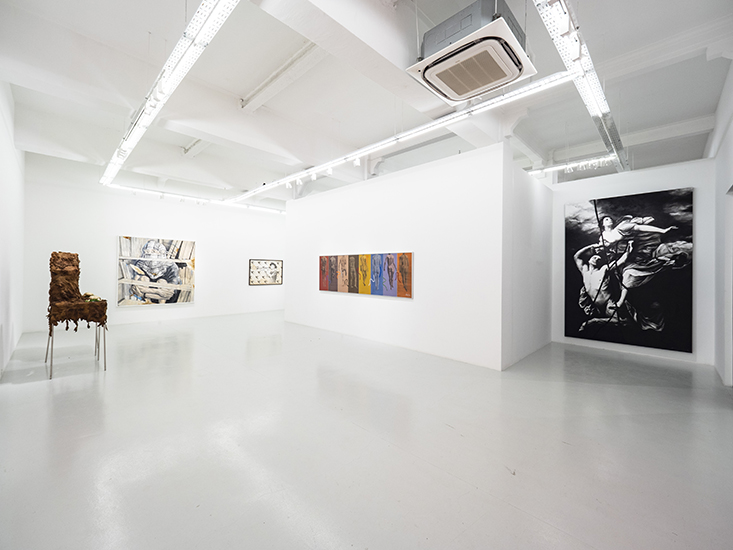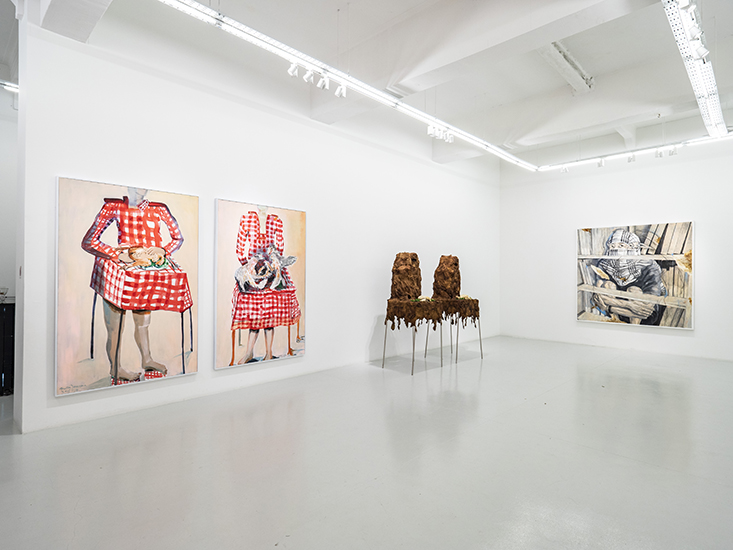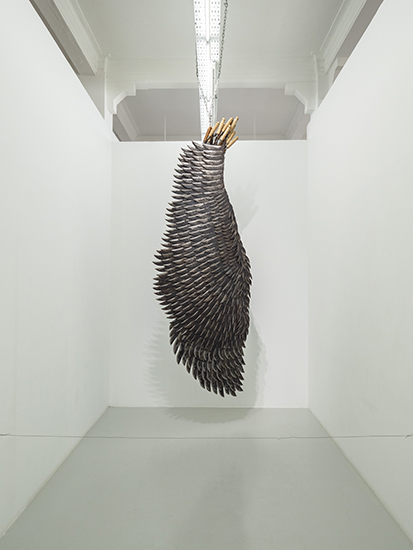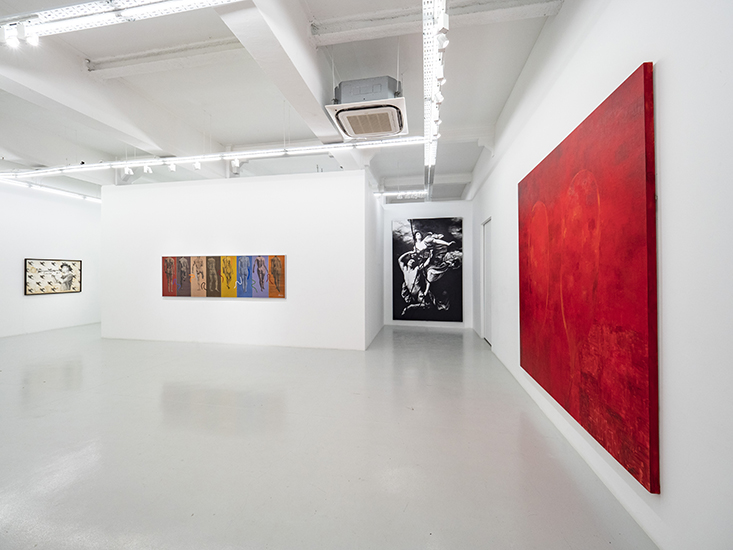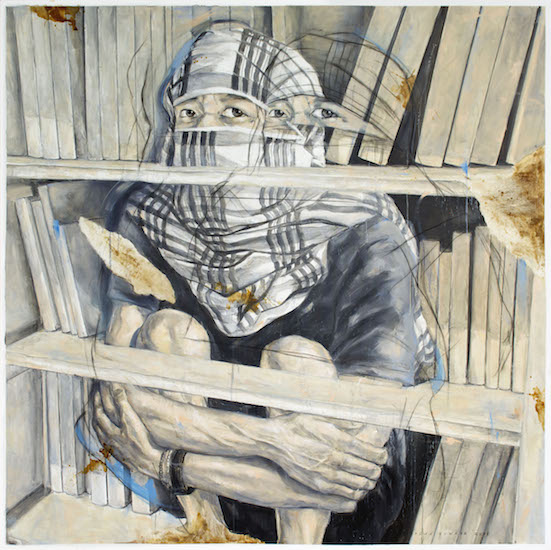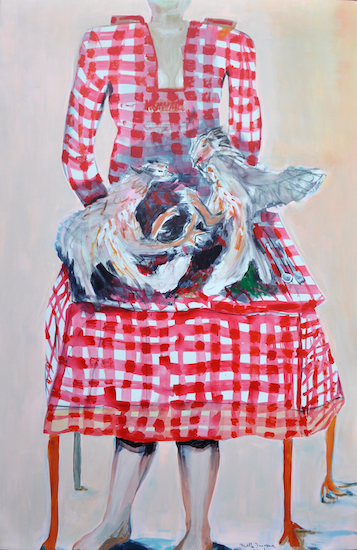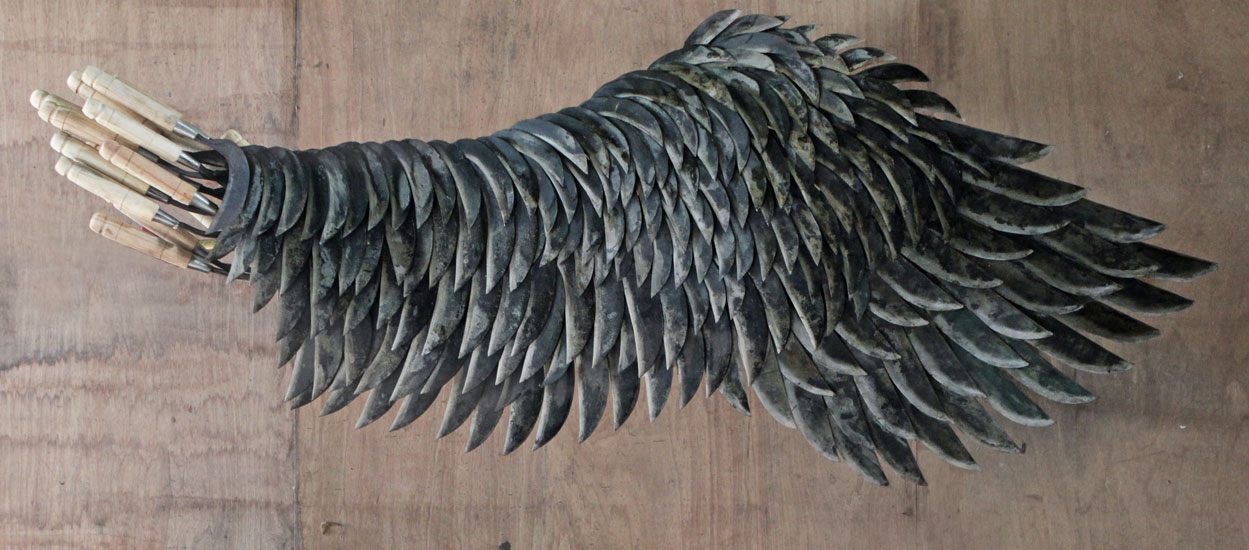Yavuz Gallery is proud to present Disparate Bodies, a group exhibition featuring internationally-acclaimed Southeast Asian artists: Agus Suwage, Mella Jaarsma, and J. Ariadhitya Pramuhendra from Indonesia; BenCab and Isabel and Alfredo Aquilizan from the Philippines; Pinaree Sanpitak from Thailand.
This exhibition presents work in a variety of media and revolves around explorations and conceptions of the Body – through its relation to being human, ideas of reassessing the self and identity, and implications arising from displacement and dispersed presence.
Agus Suwage presents two new works that explores contemporary society and its tensions through the Self. One of Indonesia’s most revered artists, Agus is known for his self-representation in a variety of forms that probe questions about Indonesian society, culture, religion in critical yet humourous and ironic ways. The self-portraits he presents are an interplay between the reflection of the Self, and the contrivance about the Self, as he relies on the camera to record a variety of his poses and facial expressions, before transforming these visual records into paintings and drawings. Though he has continually returned to this genre over his illustrious career, these personal works also investigate and reveal the artist’s stance about the various socio-political issues surrounding him and the roles of artistic practice in society. As Agus himself once stated, “in order to be critical toward others, I opt to first be critical toward myself”.
In a similar vein, Mella Jaarsma questions the positioning of self and identity, but in the context of cultural and racial signifiers embedded within clothing, the body and food. Born in the Netherlands and based in Indonesia since the 1980s, Jaarsma’s critical practice interrogates the stereotypes and performativity of complex, hybrid identities. In The Pecking Order, Jaarsma inverts and plays with the titular phrase, by producing costumes and paintings that refer to the animal most literally associated with a pecking order: the chicken. The costumes, created from chicken leather and stuffed chickens, functions as both a dress and a table to explore social organisation and hierarchies, blurring the binary division between an oppressor and the oppressed.
J. Ariadhitya Pramuhendra creates monumental charcoal works that question one’s core identity in the search for the truth and the divine. He creates uncanny realistic portraits and theatrical figurative scenes that reference historic Christian iconography and surreal science. His latest piece Angel’s Journey, from his “Beyond the Half” series continues his enquiry on self-identity and mortality within the personal context of practicing Christianity in Indonesia – one of the largest Muslim countries in the world.
Ben Cabrera, or better known as BenCab, is an icon in Philippine art. A pioneer for addressing social and political issues, as well as his portrayal of Filipino identity, he is internationally acclaimed for his draftsmanship in expressing universal human sympathies and everyday narrative drama. In his latest large-scale work, The Human Clay After Muybridge, BenCab continues his research into the human body’s movement and form. Infused with rhythmic strokes and flowing lines, the three-meter work presents eight interconnected figures in the midst of spirited movement. Weaving in iconographic references to art and scientific history, The Human Clay After Muybridge is a multi-layered and complex piece that is inspired by Eadweard Muybridge’s early motion study photographs, as well as by an exhibition entitled The Human Clay which the artist R. B. Kitaj organized in the 70s. The group exhibition, which included Francis Bacon, David Hockney, Lucien Freud and Frank Auerbach, was controversial because it championed figuration at a time when abstraction was dominant. By drawing on these key sources, BenCab similarly calls for the case of figuration, while emphasising the idea that ultimately, it is the artist’s creativity that shapes and moulds the art, like clay.
Pinaree Sanpitak’s practice similarly revolves around the human body, concentrating on the powerful and tender experience of being female and a mother. Her vibrant painting Two Red Breasts, marks a change from her monochromatic works. For well over 20 years, Sanpitak’s primary inspiration has been the female body, distilled to its most primal, basic forms: the vessel and the mound. The female breast has been a recurring motif in her considerable practice, which was brought about after the birth of her only son. Sanpitak is also often called a feminist or Buddhist artist, but she resists such easy categorisations, preferring to let her work speak to each viewer directly, through the most basic language of form, colour, and texture.
Lastly, Isabel and Alfredo Aquilizan explore community ties and displacement between groups and bodies of people through commonly found materials. Left Wing Project (Belok Kiri Jalan Terus) is a continuous series of work that examines the complex socio-political struggles that contemporary agrarian societies face in Asia. The immense sculpture consists of hundreds of hand-forged sickles, fashioned and welded into the shape of a left angel wing. The wing draws references to the leftist political history of Jogjakarta and traces their increasingly disenfranchised blacksmith communities due to Chinese economic globalism.
In celebration of the opening of Disparate Bodies, Mella Jaarsma will be presenting The Pecking Order, an hour and a half long performance at the gallery.
Click here for more information on the performance.
ABOUT THE ARTISTS
Agus Suwage was born in Purworejo, Central Java, Indonesia (1959) and trained in graphic design at the Bandung Institute of Technology. One of the most important and internationally active contemporary artists in Indonesia, Agus has been featured in over 200 exhibitions worldwide over his three decade long career. He has participated in numerous international biennials, including the Asia Pacific Triennial of Contemporary Art (1996), Gwangju Bienniale (2000), Singapore Bienniale (2006), Jogja Biennale (2007, 2013), and Prospect New Orleans (2014-15), amongst others. Recent institutional exhibitions include: Sights and Sounds, Toledo Museum of Art, Ohio, USA (2018); SUNSHOWER: Contemporary Art from Southeast Asia 1980s to Now, Mori Art Museum, National Art Center, Tokyo, Japan (2017); Manifesto V: Arus, National Gallery of Indonesia, Jakarta (2016); After Utopia: Revisiting the Ideal in Asian Contemporary Art, Singapore Art Museum (2015); Panorama: Recent Art from Contemporary Asia, Singapore Art Museum (2012); Beyond the East, Macro Museum, Rome, Italy (2011); Beyond the Self, National Portrait Gallery, Australia (2011). In 2009, Jogja National Museum, Indonesia presented Still Crazy After All These Years, a retrospective dedicated to the artist on the occasion of his 50th birthday.
Born and raised in Emmerloord, Netherlands (1960), Mella Jaarsma studied visual art at the Minerva Academy in Groningen from 1978 to 1984. Shortly after, she travelled to Indonesia to study at the Art Institute of Jakarta and at the Indonesian Institute of the Arts. Jaarsma has lived and worked in Jogjakarta, Indonesia ever since. In 1988, she co-founded Cemeti Art House with Nindityo Adipurnomo, the first space for contemporary art in Indonesia, which to this day remains an important platform for young artists and professionals in the country and region. She has received several awards: The John D. Rockefeller 3rd Award (2006); The Academic Art Award #2, Jogja Gallery / Indonesia Institute of the Arts (2008); The Jogjakarta Biennale Art Award (2010); and the ‘Adikarya Senirupa’ Visual Art Award, Ministry of Creative Industry and Tourism, Indonesia. Recent exhibitions include: SUNSHOWER: Contemporary Art from Southeast Asia 1980s to Now, Mori Art Museum, National Art Center, Tokyo, Japan (2017); the 20th Sydney Biennale, Australia (2016); The Roving Eye: Conceptual Art from Southeast Asia, ARTER Space for Art, Istanbul, Turkey (2014); Medium at Large, Singapore Art Museum (2014); GSK Contemporary – Aware: Art Fashion Identity, the Royal Academy of Arts, London, UK (2010). Jaarsma has participated in the Yokohama Triennale (2005), Gwangju Biennale (2002), and Asia Pacific Triennial of Contemporary Art (1999).
J. Ariadhitya Pramuhendra (b. 1984) graduated from Bandung Institute of Technology, majoring in Printmaking in 2007. He has participated in numerous group and solo exhibitions locally and internationally, in Indonesia, Singapore, China, Taiwan, France, UK, USA, amongst others. Recent institutional shows include: Bandung Re-Emergence, Selasar Sunaryo Art Space, Indonesia (2017); SEA+ Triennale, National Gallery of Indonesia (2013); Trans-Figurations: Indonesian Mythologies, Espace Culturel Louis Vuitton, Paris, France (2011); Biennale Jogja XI: Equator, Jogja National Museum, Indonesia (2011). In 2009, he presented Spacing Identities a two-part solo exhibition at NUS Museum, Singapore and Mapping Asia, CIGE 2009, Beijing, China. Pramuhendra has received several awards: Drawing Award, the National Taiwan Museum of Fine Art (2006); Artist of the Year, Soemardja Art Award, Indonesia (2011); and was a finalist of the 2009 Sovereign Asian Art Prize.
A National Artist for Visual Arts since his conferment in 2006, Ben Cabrera (b. 1942), or BenCab, is an icon in the Philippines. BenCab spent 13 years in London where the physical distance to his country caused him to become even more keenly aware of his root culture and the realities of life in the Philippines, where he returned to settle in 1985. A painter and printmaker, he has exhibited widely in Asia, Europe and the United States over his illustrious career spanning four decades. His works have been the subject of five books: Ben Cabrera: Etchings 1970-1980; BenCab’s Rock Sessions; BenCab Nude Drawings; BENCAB; and My BenCab: Collectors tell their stories. He established the BenCab Museum in 2009, in his mountain home of Baguio, to house his personal collection of tribal art from the Cordillera highlands, as well as contemporary Philippine art. In 2015, BenCab 50 Creative Years, a major retrospective of the artist was held across eight museums, alongside an original musical theatre production based on Sabel, an iconic subject of his works. BenCab has received several awards and honours, including: the Order of National Artist for Visual Arts, government of the Philippines (2006); honoris causa doctorate in Humanities, University of the Philippines (2009); Gawad CCP Para sa Sining (CCP Award for the Arts), Cultural Center of the Philippines (1992), amongst others.
Pinaree Sanpitak (b. 1961) is one of Thailand’s most important and well-respected contemporary artists, whose work can be counted amongst the most powerful explorations of the female experience in all of Southeast Asia. Aside from solo and group exhibitions in galleries worldwide, Sanpitak’s works have been shown in several museum shows, including the Los Angeles County Museum of Art (USA), Chrysler Museum of Art (USA), Museum voor Moderne Kunst Arnhem (The Netherlands), Singapore Art Museum, and Museum of Modern Art Tokyo (Japan). She participated in the 3rd Asia Pacific Triennial of Art in 1999, the 18th Biennale of Sydney in 2012, and the Busan Biennale in 2008. In 2007, she received the Silpathorn Award for Visual Arts from the Thai Ministry of Culture. Sanpitak’s works are included in the collections of the Fukuoka Asian Art Museum (Japan), Queensland Art Gallery, Gallery of Modern Art (Australia), Bill & Melinda Gates Foundation (USA), Nasher Museum of Art (USA), Chulalongkorn University, Bangkok (Thailand), and the National Heritage Board (Singapore).
Philippines-born husband-and-wife artists Isabel and Alfredo Aquilizan (b. 1965 and 1962) have been based in Brisbane, Australia since 2006. Their collaborative practice often evolve around the spheres of home and family, exploring the notions of identity and belonging, journey and displacement, sensing presences in absence and accumulating memory. They continue to process these issues through materials and objects that are both abstract and referential, objects that serve as metaphors of everyday human life. The works of Isabel and Alfredo Aquilizan have been exhibited extensively in galleries and institutions worldwide, including the Thailand Biennale (2018); Gangwon International Biennale, South Korea (2018); Sharjah Biennale, UAE (2013); Asia Pacific Triennale, Australia (2009); Singapore Biennale (2008); Biennale of Sydney, Australia (2006); Gwangju Biennale, South Korea (2004), Venice Biennale, Italy (2003). Their works are included in the major collections such as the Sherman Contemporary Art Foundation (Australia); Singapore Art Museum; Fukuoka Asian Art Museum (Japan); Queensland Art Gallery (Australia); and Lopez Museum Foundation (Philippines).
